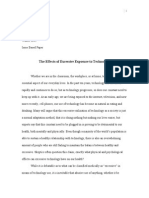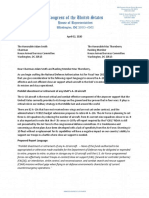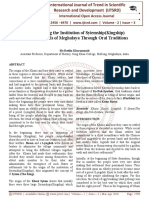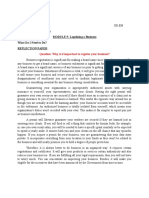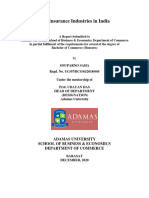Impacts of Digital Interventions in Everyday Lives
Srishti Bhavsar
Lab Pro B
In today's time, digital devices have become an integral part of our daily lives. Whether
for work, communication, entertainment, or education, technology touches nearly every
aspect of life. While these advancements have brought about countless conveniences
and opportunities, there is a growing concern over how the pervasive use of these
devices affects our social interactions, emotional well-being, and even our physical
safety. Through the lens of several common everyday situations, we can see the
growing disconnection from reality and from one another that is creeping into our lives
as we become more engrossed in the digital world.
The Family Dinner Table: A Place of Silence
One of the most striking examples of the intrusion of digital devices into our lives is the
way they have altered family dynamics, particularly during moments that were once
sacred for connection, such as family dinners. In many households, the dinner table
was a place for parents and children to talk about their day, share thoughts, and bond.
Unfortunately, it is becoming more and more common to see family members sitting
together, physically present but mentally and emotionally detached as they scroll
through their phones.
Parents might be catching up on work emails or mindlessly scrolling through social
media, while children are glued to games or chatting with friends online. Instead of
having conversations, they are consumed by their devices, often unaware of what is
happening around them. This behavior fosters a sense of isolation within the family unit,
despite physical proximity. The lost opportunity for meaningful connection can lead to
emotional distance, communication breakdowns, and a general weakening of family
bonds. The consequences of this can be profound, leading to feelings of neglect among
children, a lack of familial cohesion, and the erosion of basic social skills. In an age
where technology seems to bring us closer to those far away, it ironically distances us
from those closest to us.
Friends Without Real Conversations: The Death of Social Interaction
Picture two friends meeting for lunch. They sit side by side but, rather than engaging in
conversation, they are both silently immersed in their screens, sending each other funny
�videos or reels. While it may seem like a way of sharing an experience, this mode of
interaction removes the depth that comes from actual conversation.
When two people communicate through texts or shared media rather than talking, the
richness of body language, tone, and emotional cues is lost. There's little room for
spontaneous dialogue, deep discussion, or even arguments that help people
understand each other better. Instead, digital communication creates a shallow
substitute for the dynamic exchange of thoughts and feelings that face-to-face
conversations provide.
Furthermore, this constant engagement with phones during social interactions suggests
a kind of dependence on digital content to fill conversational gaps. It’s as though we’ve
forgotten how to engage meaningfully without the crutch of digital entertainment. As a
result, friendships may become superficial, based more on shared memes than on
personal connection and understanding. Social media, in this sense, contributes to a
growing alienation among individuals, even as they strive to remain constantly
"connected."
The Physical Risks: Distracted and Unaware
Beyond emotional and social consequences, over-reliance on digital devices also
carries physical risks. We've all heard stories about people getting into accidents
because they were too busy texting or checking their phones to pay attention to their
surroundings. In many ways, our phones have become extensions of ourselves. They
are always within reach, and for many, the urge to check them constantly feels almost
instinctual. However, this constant engagement with our devices reduces our
awareness of the world around us, which can have dire consequences. In more extreme
cases, distracted pedestrians may find themselves stepping into traffic without looking
or failing to notice hazards in their environment, leading to accidents and injuries.
The issue isn’t just about being clumsy or inattentive. It reflects a broader problem of
how digital devices can dominate our attention, even at the expense of our safety. As
we become more accustomed to splitting our focus between the digital and physical
worlds, we may be losing our ability to be fully present in any given moment, a skill that
is essential for both our safety and well-being.
The Long-Term Implications: A Society in Decline?
While these individual examples may seem trivial or temporary, the cumulative effects of
over-reliance on digital devices could be far-reaching. Human beings are social
creatures by nature, and our ability to communicate, connect, and empathize with one
another is what makes society function. If we continue down a path where digital
�interactions increasingly replace real-life experiences, we risk eroding the very fabric of
what makes us human.
The emotional toll of constantly being plugged in is already being felt by many. Studies
show that excessive use of digital devices can contribute to mental health issues such
as anxiety, depression, and feelings of isolation. As people spend more time on social
media, comparing their lives to others' curated highlights, feelings of inadequacy and
loneliness often increase. Likewise, children who grow up in households where
technology use is prioritized over personal connection may struggle to develop healthy
emotional and social skills, setting the stage for problems in their adult relationships.
Moreover, the physical toll should not be underestimated. From strained eyesight to
poor posture, the sedentary lifestyle that often accompanies excessive device use has
its own set of health concerns, including obesity and heart disease. The longer we allow
our devices to dominate our lives, the more these negative consequences will
compound.
Finding Balance: A Hopeful Future?
Despite these concerns, it is important to recognize that digital devices and technology
are not inherently bad. When used responsibly and in moderation, they can enrich our
lives in countless ways. The key is to strike a balance, using technology as a tool rather
than allowing it to control us.
Families can establish device-free zones, such as the dinner table, where conversation
and connection take priority. Friends can consciously put their phones away when they
meet, choosing to engage with each other rather than their screens. Individuals can set
personal boundaries, scheduling time away from their devices to reconnect with the
physical world. By becoming more mindful of how we use technology, we can reclaim
our time, attention, and relationships. In doing so, we have the opportunity to enjoy the
best of both worlds—embracing the benefits of digital devices while preserving the
richness of human connection.
As we navigate an increasingly digital world, it is vital to reflect on the impacts that these
devices have on our lives. From the disconnection at family dinners to the shallow
interactions between friends and the physical dangers of distracted behavior, the
pervasive use of digital devices is reshaping our social and emotional landscapes.
However, with awareness and intentional effort, we can mitigate these effects and foster
a healthier, more balanced relationship with technology.













